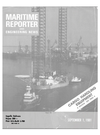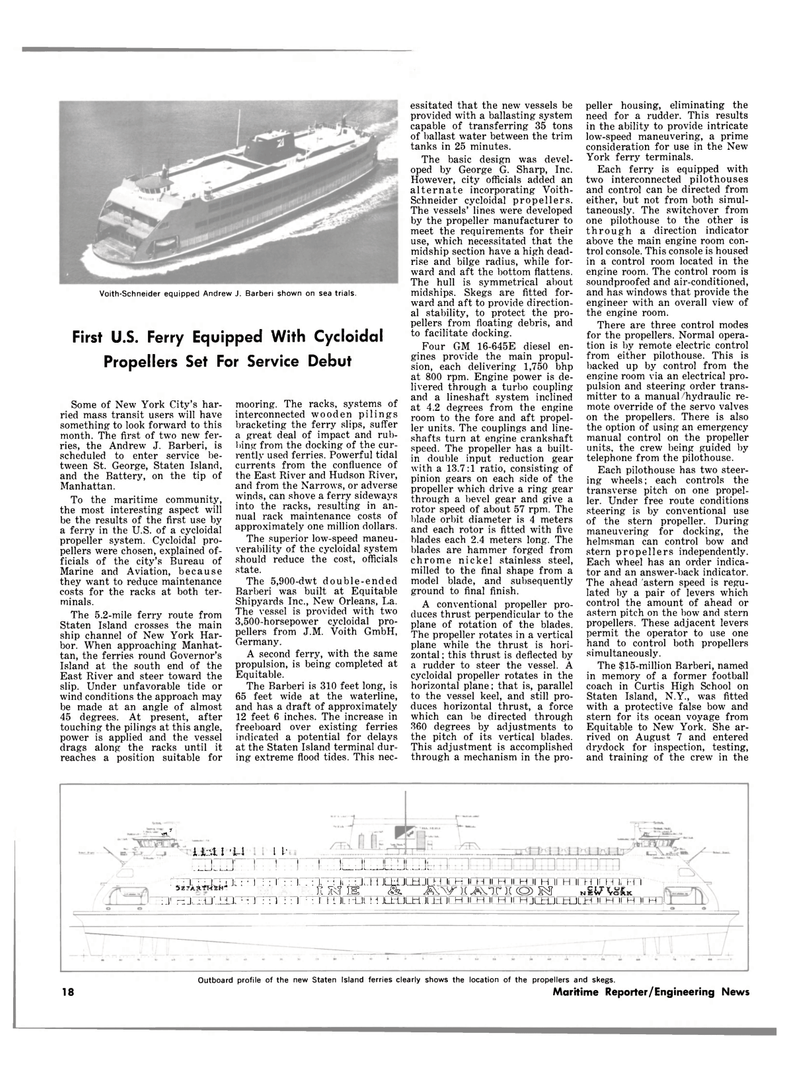
Page 16: of Maritime Reporter Magazine (September 1981)
Read this page in Pdf, Flash or Html5 edition of September 1981 Maritime Reporter Magazine
Voith-Schneider equipped Andrew J. Barberi shown on sea trials.
First U.S. Ferry Equipped With Cycloidal
Propellers Set For Service Debut
Some of New York City's har- ried mass transit users will have something- to look forward to this month. The first of two new fer- ries, the Andrew J. Barberi, is scheduled to enter service be- tween St. George, Staten Island, and the Battery, on the tip of
Manhattan.
To the maritime community, the most interesting aspect will be the results of the first use by a ferry in the U.S. of a cycloidal propeller system. Cycloidal pro- pellers were chosen, explained of- ficials of the city's Bureau of
Marine and Aviation, because they want to reduce maintenance costs for the racks at both ter- minals.
The 5.2-mile ferry route from
Staten Island crosses the main ship channel of New York Har- bor. When approaching Manhat- tan, the ferries round Governor's
Island at the south end of the
East River and steer toward the slip. Under unfavorable tide or wind conditions the approach may be made at an angle of almost 45 degrees. At present, after touching the pilings at this angle, power is applied and the vessel drags along the racks until it reaches a position suitable for mooring. The racks, systems of interconnected wooden pilings bracketing the ferry slips, suffer a great deal of impact and rub- bing from the docking of the cur- rently used ferries. Powerful tidal currents from the confluence of the East River and Hudson River, and from the Narrows, or adverse winds, can shove a ferry sideways into the racks, resulting in an- nual rack maintenance costs of approximately one million dollars.
The superior low-speed maneu- verability of the cycloidal system should reduce the cost, officials state.
The 5,900-dwt double-ended
Barberi was built at Equitable
Shipyards Inc., New Orleans, La.
The vessel is provided with two 3,500-horsepower cycloidal pro- pellers from J.M. Voith GmbH,
Germany.
A second ferry, with the same propulsion, is being completed at
Equitable.
The Barberi is 310 feet long, is 65 feet wide at the waterline, and has a draft of approximately 12 feet 6 inches. The increase in freeboard over existing ferries indicated a potential for delays at the Staten Island terminal dur- ing extreme flood tides. This nec- essitated that the new vessels be provided with a ballasting system capable of transferring 35 tons of ballast water between the trim tanks in 25 minutes.
The basic design was devel- oped by George G. Sharp, Inc.
However, city officials added an alternate incorporating Voith-
Schneider cycloidal propellers.
The vessels' lines were developed by the propeller manufacturer to meet the requirements for their use, which necessitated that the midship section have a high dead- rise and bilge radius, while for- ward and aft the bottom flattens.
The hull is symmetrical about midships. Skegs are fitted for- ward and aft to provide direction- al stability, to protect the pro- pellers from floating debris, and to facilitate docking.
Four GM 16-645E diesel en- gines provide the main propul- sion, each delivering 1,750 bhp at 800 rpm. Engine power is de- livered through a turbo coupling and a lineshaft system inclined at 4.2 degrees from the engine room to the fore and aft propel- ler units. The couplings and line- shafts turn at engine crankshaft speed. The propeller has a built- in double input reduction gear with a 13.7:1 ratio, consisting of pinion gears on each side of the propeller which drive a ring gear through a bevel gear and give a rotor speed of about 57 rpm. The blade orbit diameter is 4 meters and each rotor is fitted with five blades each 2.4 meters long. The blades are hammer forged from chrome nickel stainless steel, milled to the final shape from a model blade, and subsequently ground to final finish.
A conventional propeller pro- duces thrust perpendicular to the plane of rotation of the blades.
The propeller rotates in a vertical plane while the thrust is hori- zontal; this thrust is deflected by a rudder to steer the vessel. A cycloidal propeller rotates in the horizontal plane; that is, parallel to the vessel keel, and still pro- duces horizontal thrust, a force which can be directed through 360 degrees by adjustments to the pitch of its vertical blades.
This adjustment is accomplished through a mechanism in the pro- peller housing, eliminating the need for a rudder. This results in the ability to provide intricate low-speed maneuvering, a prime consideration for use in the New
York ferry terminals.
Each ferry is equipped with two interconnected pilothouses and control can be directed from either, but not from both simul- taneously. The switchover from one pilothouse to the other is through a direction indicator above the main engine room con- trol console. This console is housed in a control room located in the engine room. The control room is soundproofed and air-conditioned, and has windows that provide the engineer with an overall view of the engine room.
There are three control modes for the propellers. Normal opera- tion is by remote electric control from either pilothouse. This is backed up by control from the engine room via an electrical pro- pulsion and steering order trans- mitter to a manual /hydraulic re- mote override of the servo valves on the propellers. There is also the option of using an emergency manual control on the propeller units, the crew being guided by telephone from the pilothouse.
Each pilothouse has two steer- ing wheels; each controls the transverse pitch on one propel- ler. Under free route conditions steering is by conventional use of the stern propeller. During maneuvering for docking, the helmsman can control bow and stern propellers independently.
Each wheel has an order indica- tor and an answer-back indicator.
The ahead astern speed is regu- lated by a pair of levers which control the amount of ahead or astern pitch on the bow and stern propellers. These adjacent levers permit the operator to use one hand to control both propellers simultaneously.
The $15-million Barberi, named in memory of a former football coach in Curtis High School on
Staten Island, N.Y., was fitted with a protective false bow and stern for its ocean voyage from
Equitable to New York. She ar- rived on August 7 and entered drydock for inspection, testing, and training of the crew in the 1
Sk i.i^i'U 1 V
SlUF^ : ; ' I I : : 1 JLJ5S: ; lb rrrTTTirn iE7A RfH EN" ]l rJ J : I : : T • Hi H U i li H II H II H 11 H II H II H II H II H I! H II H II Hl~FrT . : m is ^thateom ..svw* •LH ]. hUr yZT: :T r"H. H.JL: i ll 1i JLhULkLJUrL )UdJUdJIIHIIUdJLJd_JL±±JLJriJLJ=ULidJIIH 18
Outboard profile of the new Staten Island ferries clearly shows the location of the propellers and skegs.
Maritime Reporter/Engineering News

 15
15

 17
17
